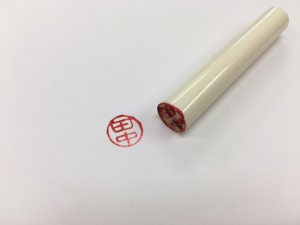A hanko is typically made of wood, plastic or ivory, and has one’s name carved out at the bottom. In the same way as the Western nations use signatures, Japanese people use hankos to conduct various business transactions. There are two types of hanko—Jitsuin and Mitomein. Jitsuin is registered with the government and is used in legal documents. Mitomein is also called Sanmonban and is used more casually such as when one receives a package from a delivery service.
When you have a non-Japanese name, it is difficult to find a hanko in a store with your name. For this reason, NILS orders hankos for all students. Most of NILS students’ names are carved in Kanji except for students from nations that use Chinese characters. In selecting Kanji, we choose letters based on the phonetics.
NILS students use their hankos when opening bank accounts. Since you are required to use your hanko when withdrawing funds or exchanging foreign currencies, please take care of your hanko. Your hanko is part of your legal identify, and as such, it’s important to treat it with care. For example, I recommend you keep your hanko and bank passbook in separate places so as to minimize the risk of having them both stolen and used by someone pretending to be you.











